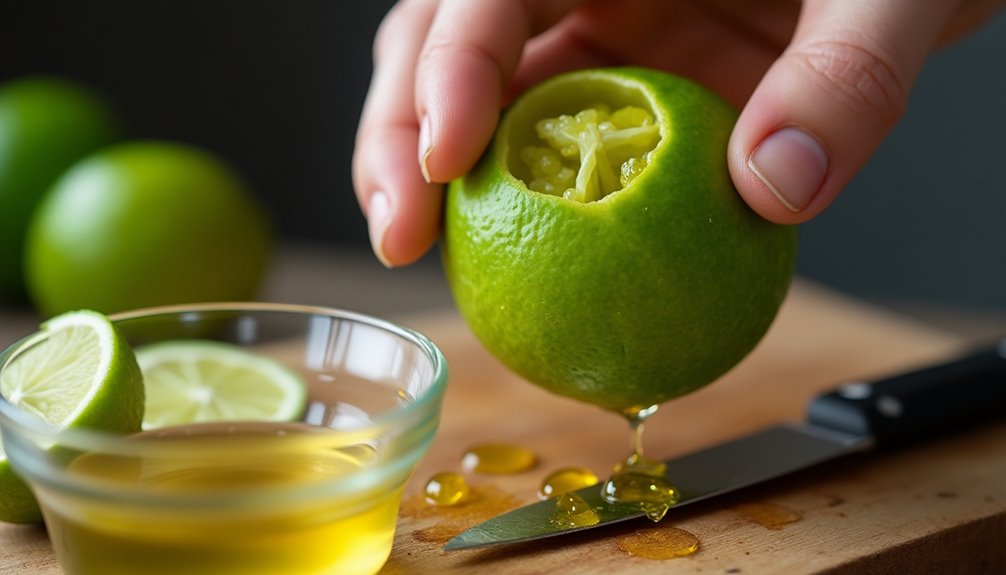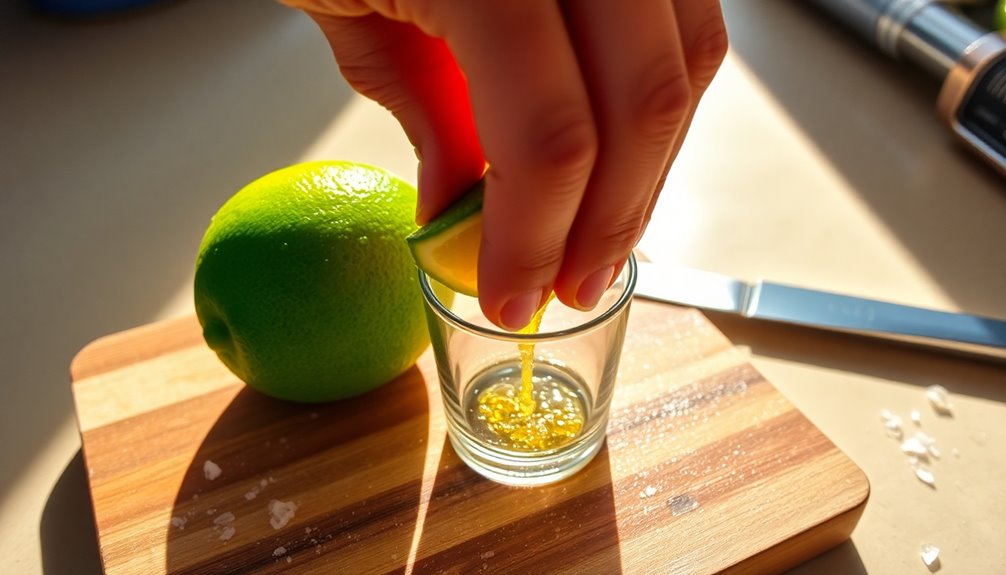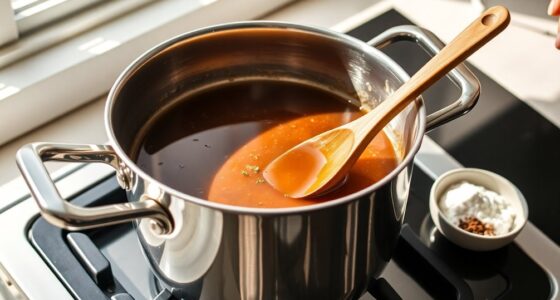To juice a lime without a juicer, start with a fresh lime at room temperature. Cut it in half across the width for maximum juice. Hold one half over a bowl and use a fork to twist and squeeze out the juice, applying pressure as you go. For tougher limes, microwave them for 15-20 seconds to soften the flesh. You'll enjoy the fresh flavor in your recipes, and there are more tips to enhance your juicing technique.
Key Takeaways
- Start with a room-temperature lime and roll it on a hard surface to break down juice vesicles for easier extraction.
- Cut the lime in half across the width to maximize juice yield.
- Use a fork to twist and squeeze each half over a bowl, applying pressure to extract all the juice.
- If the lime is tough, microwave it for 15-20 seconds to soften the fruit before cutting.
- Fresh lime juice enhances flavors in cocktails, dressings, and marinades, making it a versatile ingredient.

Juicing a lime without a juicer might seem tricky, but it's actually quite simple if you follow a few easy steps. First, you'll want to start with a fresh lime at room temperature. If it's been in the fridge, let it sit out for a bit. This helps soften the fruit, making juice extraction much easier. One medium lime can yield about 2 tablespoons of juice, so keep that in mind when planning for your recipe.
Next, roll the lime on a hard surface like your countertop. Use the palm of your hand to apply gentle pressure as you roll it back and forth. This action breaks down the juice vesicles inside the lime, making it easier for the juice to come out when you cut and squeeze it. It's a simple technique, but it significantly boosts the amount of juice you'll be able to extract.
Once you've rolled the lime, it's time to cut the lime. Make sure you cut the lime in half across the width, not lengthwise. Cutting it this way maximizes juice extraction, ensuring you get every last drop of fresh lime juice. After cutting the lime into two halves, you'll be ready for the next step.
Now, grab a fork. This is where the real extraction happens. Take one of the lime halves and hold it over a bowl. Use the fork to twist and squeeze the lime. As you do this, you'll see the juice comes pouring out. Don't be afraid to really dig in and apply some pressure. The goal here is to release as much juice as possible while minimizing waste. Repeat this process with the other lime half.
If you find that the lime is still a bit tough and not yielding as much juice as you'd like, there's a trick you can use. Before cutting the lime, pop it in the microwave for about 15-20 seconds. This quick blast of heat will help soften the fruit further, allowing you to extract even more juice. Just be careful not to overheat it, as you don't want to cook the lime.
Using these techniques, you can easily extract fresh lime juice without needing any fancy equipment. Whether you're making a cocktail, dressing, or a marinade, you'll appreciate having fresh lime juice on hand. Just remember to roll the lime first, cut it across the width, and use a fork for maximum juice extraction. With these simple methods, you'll be able to enjoy the bright, zesty flavor of fresh lime juice in no time!
Frequently Asked Questions
How Can You Juice a Lime Without a Juicer?
To juice a lime, start by rolling it on the countertop to break down the juice vesicles.
Cut it in half crosswise to get the most juice. Use a fork to twist and squeeze the halves for extra juice.
If you want an easier extraction, microwave the lime for 15-20 seconds before cutting.
For even better results, try a handheld reamer or citrus squeezer to press the halves directly into your bowl or glass.
How to Juice a Lime With a Fork?
You've got a lime, and you need that juice—now what?
First, roll the lime on the countertop to break those juice vesicles. Cut it in half crosswise, then hold one half over a bowl, cut side down.
Grab a fork, pierce the flesh, and twist while pressing down. Keep squeezing and twisting until you've extracted all that zesty juice.
You'll get about two tablespoons, perfect for your next recipe!
How to Juice Citrus Without a Juicer?
To juice citrus without a juicer, start by rolling the fruit on a countertop to break down the juice vesicles.
Cut it in half crosswise for easier extraction. Use a fork to twist and press into the halves, reaching the membranes for maximum juice.
If the fruit's tough, microwave it for 15-20 seconds to soften.
For a cleaner approach, squeeze over a bowl, capturing all the juice without the mess.
Enjoy your fresh juice!
How to Juice Key Limes Quickly?
To juice key limes quickly, start by rolling them on a countertop to soften their membranes, which helps release more juice.
Next, cut the limes in half horizontally to expose the juice-filled segments. Use a fork to twist and press the halves for efficient extraction.
If you need even more juice, microwave the limes for 15-20 seconds before cutting.
Conclusion
In the end, juicing a lime without a juicer isn't just possible; it's an adventure in your kitchen! With a few simple techniques at your fingertips, you'll unlock the zesty flavor of fresh lime juice for your favorite dishes and drinks. So why let a lack of gadgets hold you back? Embrace the challenge, and let your culinary creativity shine. After all, the best flavors often come from a little ingenuity and a squeeze of your hands!
Cindy thoroughly researches juicing trends, techniques, and recipes to provide readers with practical advice and inspiration. Her writing style is accessible, engaging, and designed to make complex concepts easy to understand. Cindy’s dedication to promoting the advantages of juicing shines through her work, empowering readers to make positive changes in their lives through the simple act of juicing.











